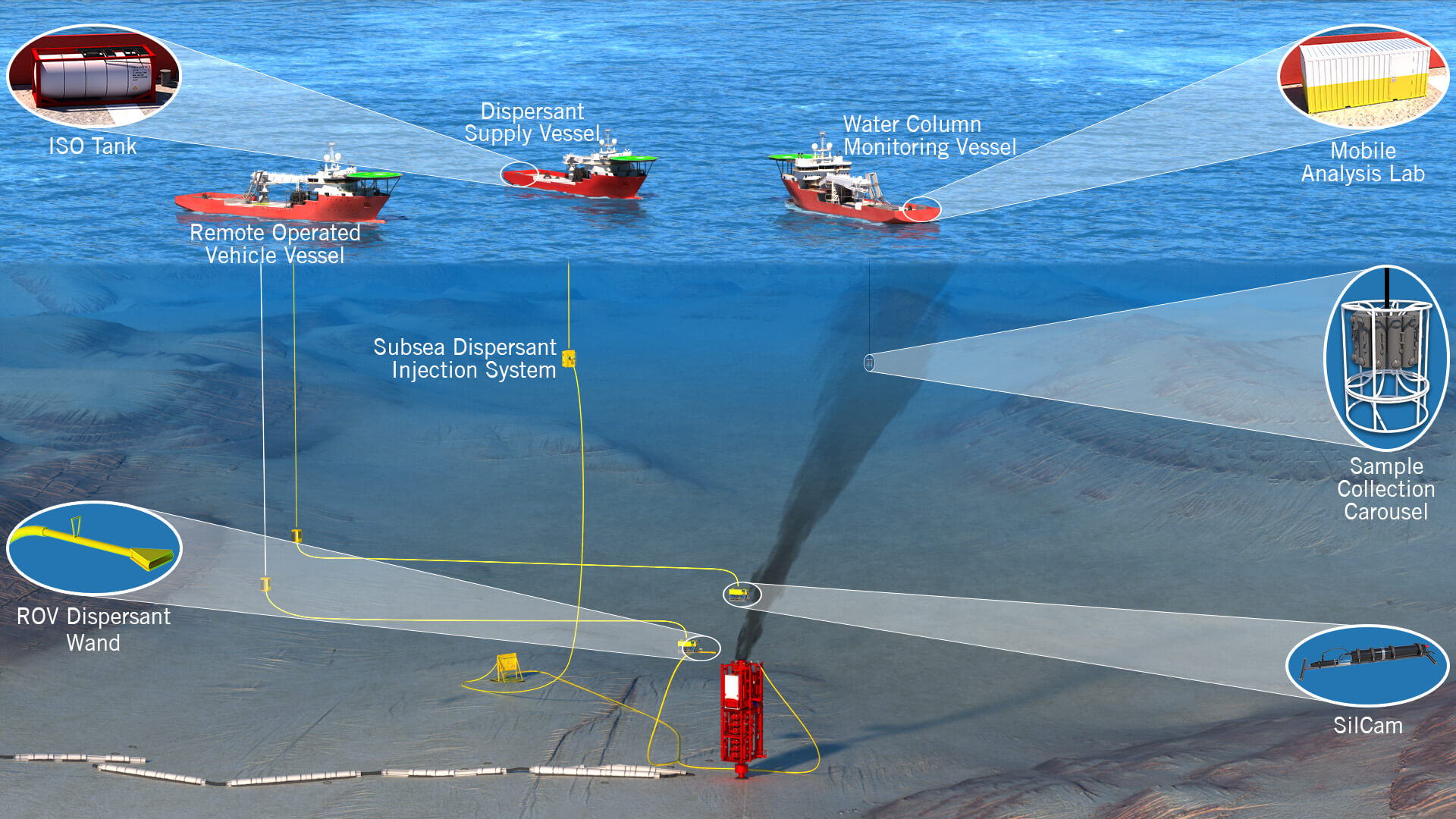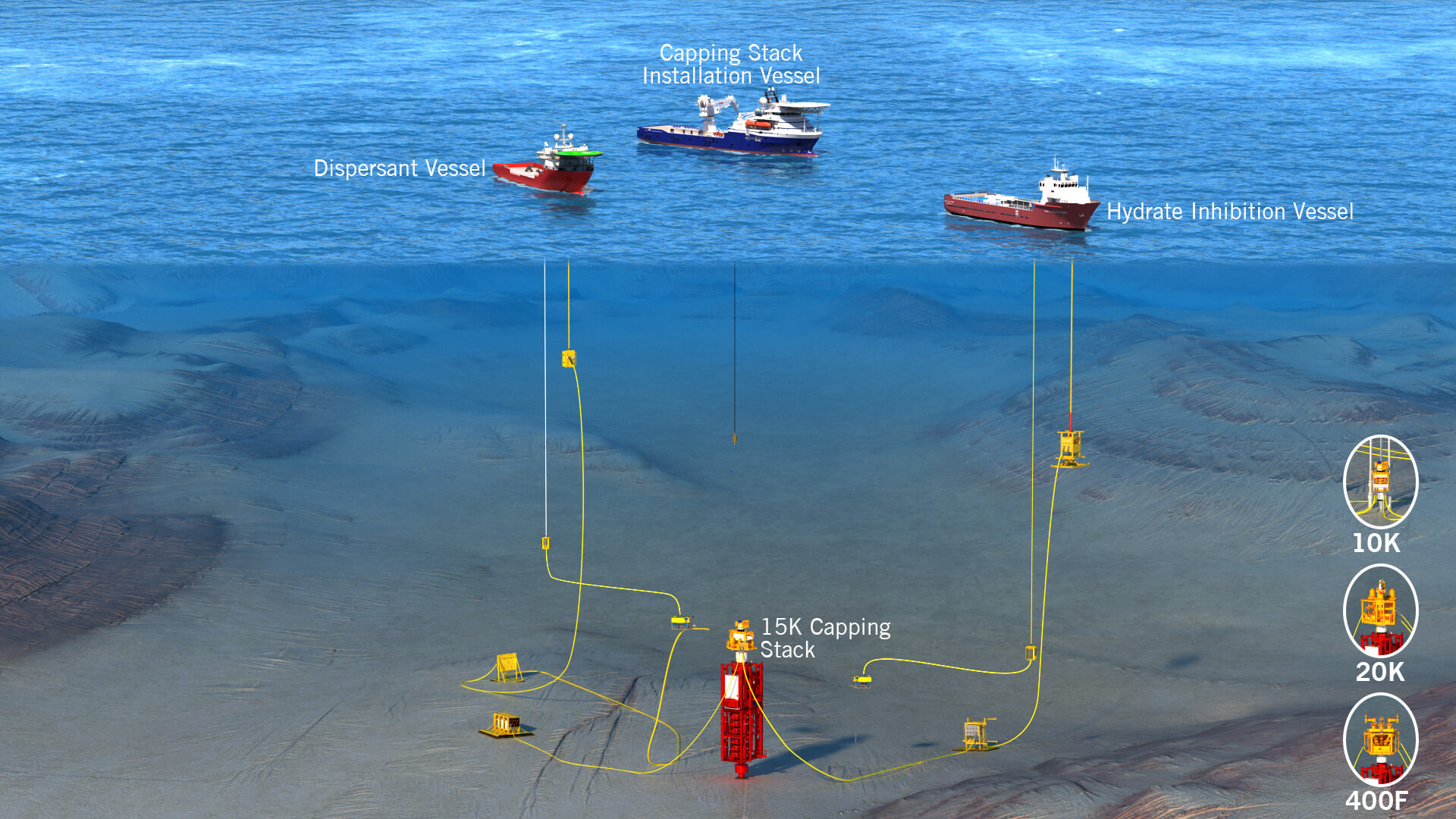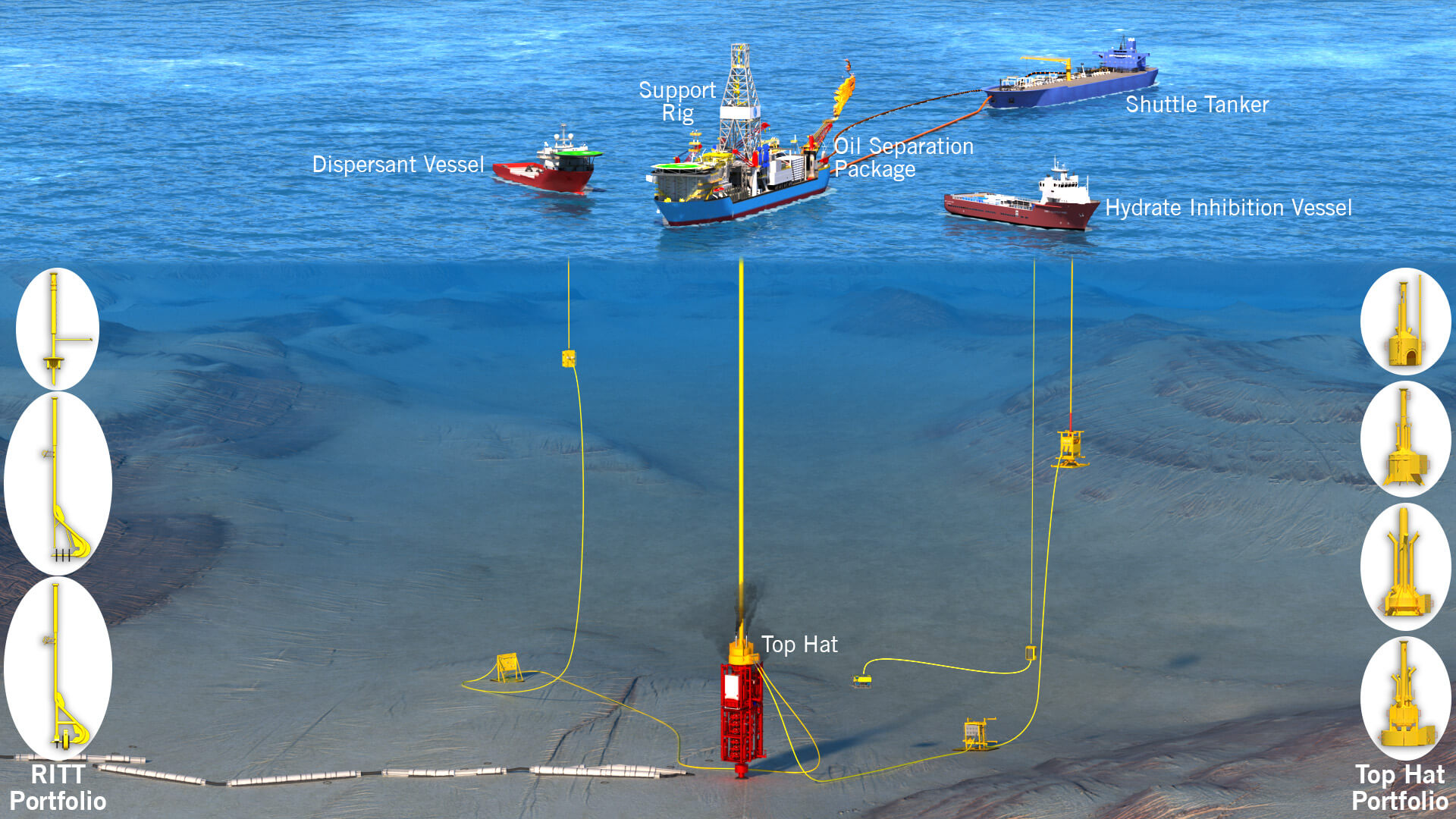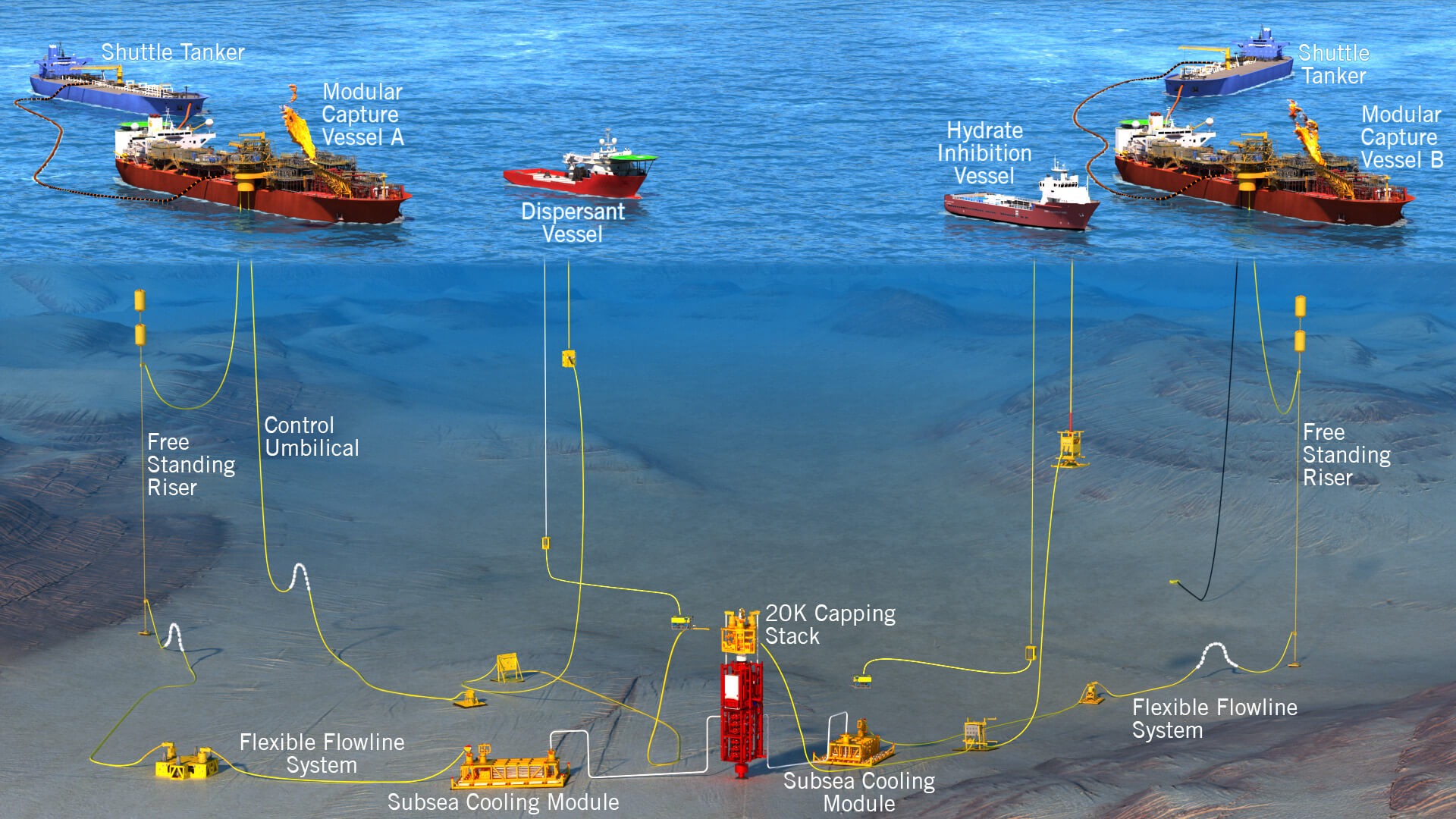Containment
System
Marine Well Containment Company’s (MWCC) Containment System was created with safety and flexibility in mind. We have several key systems for subsea dispersion, well capping, interim collection and extended flowback which allows MWCC to respond to a wide array of well control incidents. The system is specially designed to operate up to two miles below the surface, with portions of our system able to handle fluids up to 400 degrees Fahrenheit, which is nearly twice the boiling point of water.
MWCC maintains its equipment at two shore bases along the U.S. Gulf Coast. Dedicated staff at each site constantly test and maintain the systems to ensure they’re always ready to respond.

Subsea Dispersant
Similar to how dish soap breaks up grease when washing a frying pan, MWCC has dispersant injection equipment to break up hydrocarbons at the wellhead, which helps to protect responders and reduce environmental impact. Dispersant injected at the wellhead breaks up oil at the point of release and limits the collection of well fluids at the surface of the water. Dispersants have been used for decades to break up pooling hydrocarbons, which protects Responders from volatile organic compounds (VOCs) and allows safer access to the compromised well.
In the past, dispersant was typically applied at the surface of the water or dropped from the air after well fluids had accumulated on the surface. MWCC is among the first to have subsea dispersant equipment capable of pumping dispersant directly into the well at the point of release, up to two miles below the surface. Subsea application has proven more effective than surface applications and can require up to five times less dispersant solution than traditional methods.
Dispersant application must be authorized by the Environmental Protection Agency (EPA) through a request and approval process initiated by the Well Operator. The EPA determines if and how subsea dispersant should be used in an incident. If dispersant is approved for use, the amount applied is set by the EPA.
To support the Well Operator and Regulators in determining how effective dispersant application is in each unique incident, MWCC maintains and operates a Water Column Monitoring System. MWCC was the first source control provider to have this dedicated technology, which allows for real-time sample collection and analysis of sea water at various depths from the well site up to the surface.
MWCC’s Subsea Dispersant Injection System (SDIS) pumps dispersant from a marine vessel on the surface through a system of flexible piping to an applicator positioned at the release point.

Well Capping
MWCC’s main goal is to shut off the flow of fluids from a compromised well using a primary containment device called a capping stack. A capping stack is a series of valves that can be installed on top of a compromised well to shut off the flow of fluids.
The drilling assembly on the seafloor, which consists of the Blow Out Preventer (BOP) and Lower Marine Riser Package, is massive and about 60 feet tall. This size is comparable to two school buses stacked end-to-end weighing almost 400 metric tons, or about the same as 68 elephants. An incident in a structure this large requires a similar sized containment solution. MWCC’s capping stacks are taller than a two-story building with a maximum weight of 112 metric tons, which is about the same size as 45 full-sized SUVs. Each capping stack has been purpose-designed and built to ensure MWCC can respond to a diverse array of scenarios effectively.
MWCC has four capping stacks in its portfolio ranging in size and capability. Each capping stack is capable of operating in depths ranging from 500 to 10,000 feet of water. Members submit each specific well design to MWCC’s engineers to be evaluated for system compatibility. Additionally, MWCC engineers validate Operators’ containment plans and cite one of our four unique capping stacks to best fit the needs of every well. To meet the demands of our members, MWCC’s capping stack portfolio advances with industry drilling capabilities, especially around higher pressure and temperature reservoirs of hydrocarbons. Our portfolio of capping stacks is designed to manage 10,000 to 20,000 PSI of pressure and 250 degrees to 400 degrees Fahrenheit. MWCC has engineered our capping stacks to attach to a variety of locations on a compromised well, such as at the marine riser adaptor, the top of the BOP, directly on top of a wellhead or secured onto the well casing. To achieve flexibility in capping stack connection, MWCC has a variety of connectors that we can change out to fit the unique needs of an incident. Further, MWCC has the first industry wellhead straightening tool. This piece of equipment works like a chain jack to pull a damaged wellhead into a more vertical position for easier connection with a capping stack.

Interim Collection
Should a situation arise where a well can’t be immediately shut off with a capping stack, MWCC has collection equipment to minimize the release of well fluids into the environment. Our top hats and Riser Insertion Tube Tools (RITT) can collect up to 15,000 barrels per day, which is enough to fill over 15,000 bathtubs.
MWCC has five top hats and three riser insertion tube tools (RITT) in its portfolio. A top hat basically works like a funnel, sitting over top of a leaking well, collecting oil and directing it to a support rig on the surface for disposal. A RITT looks a lot like a straw that can be inserted inside of a broken riser pipe to collect and direct oil to a support rig for disposal.
MWCC keeps a oil separation package on retainer, which is installed on the support rig at the surface to separate and dispose of the collected well fluids. The oil separation package has the ability process up to 15,000 barrels of oil a day and flare up to 50 million standard cubic feet per day of natural gas.
Interim collection equipment can be deployed by the Operator while MWCC is mobilizing its more extensive flowback solution to the incident site.

Extended Flowback
In a situation where a well cannot be capped, MWCC creates a closed loop system to contain well fluids using extended flowback equipment. The extended flowback system is tailored to site specific requirements including water depth, seafloor landscape, well flow rates, ocean currents and debris field. In this scenario, MWCC would still install the capping stack but rather than shutting off the flow, a series of flexible pipes, or flowlines, are linked to the capping stack which then route well fluids up to a Modular Capture Vessel (MCV) at the surface.
Deepwater drilling in the U.S. Gulf of America is defined as 500 to 10,000 feet of water. This is a broad range which requires MWCC’s extended flowback system to be adaptable. In an incident at water depths of 500 to 2,000 feet, MWCC uses lazy-wave risers to hook the capping stack up to the capture vessels. A lazy wave configuration is a simple flowback solution that utilizes buoyancy and is attached to flexible pipes used to move fluid from the well to the ship. In water depths above 2,000 feet, MWCC uses a free standing riser to hook the capping stack up to the capture vessels. A free-standing riser is a series of vertical pipes that are connected and suspended in the water from the seafloor using giant buoyancy cans.
MWCC has two dedicated tanker vessels called Modular Capture Vessels (MCV). MCVs are standard oil tankers customized to process and capture well fluids. Each of MWCC’s MCVs are larger than a Naval battleship and have the capability to separate the oil and flare, or burn off, the natural gas. Separated water, oil and sand are stored in the capture vessel and can be offloaded to a shuttle tanker when capacity is reached. Combined, the MCVs have the capacity to capture up to 100,000 barrels of oil and flare up to 200 million standard cubic feet per day (MMSCFD) of gas, which is enough oil to fuel more than three million cars.
The MCVs are equipped with Dynamic Positioning (DP2) capability which allows them to maintain a fixed position without anchors. MCVs can be stationed up to a mile away from the incident site which reduces response traffic directly over the well site and increases the safety of our Response Team by keeping them out of the direct response field.
Response Team
MWCC’s staff and Reservist Response Team are at the top of the industry, bringing decades of subject matter expertise…
Drills & Exercises
MWCC recognizes that hiring the brightest minds in our industry isn’t enough; it is our responsibility to provide…
Resources & Capabilities
Marine Well Containment Company’s (MWCC) industry-leading approach to deepwater well control incidents…